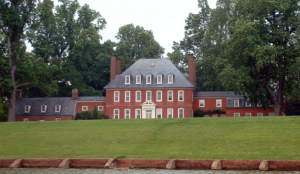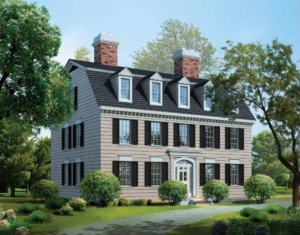Colonial style homes, just like the name implies, were built by colonists who, at the time, arrived in a new land and would be calling America home. Gaining inspiration from their mother land, each of these Colonial style homes have their own flair as well as their own story. In our lovely list of six Colonial Style Homes, we cover: First Period English, French Colonial, Spanish Colonial, Dutch Colonial, Georgian Colonial, and the Adam Federal home style.
FIRST PERIOD ENGLISH

The First Period in America lasted from approximately 1626 through 1725. First Period Homes were built by English Colonists arriving in the New World. They were built out of necessity and for the sake of survival. In order to make the most of the heat from the sun, the front of First Period English style homes faced south. Homes of this style are asymmetrical, feature steeply pitched roofs, include large central chimneys, small diamond-paned windows, and have two stories. Roofs are usually finished with wooden shingles. Homes of this style could easily be described as being rather plain and lacking any sort of exterior ornamentation. It’s for this reason that it’s been argued whether or not this home style is even legitimate, being that the original First Period English style homes were built with no design plans and were usually void of an architect.
*The paragraph below is an excerpt from our article on “7 Types of Elegant French Style Homes”.
FRENCH COLONIAL

Zillow, $1,985,000 French Colonial Home for Sale in Madisonville, LA
French Colonial architecture was born out the 16th century, when it was used by the French during their colonization of the Americas. France founded many colonies in eastern North America, in addition to a number of islands such as the Caribbean Islands and South America. They began to learn and adapt the building practices common in the Caribbean and the West Indies, that were designed to protect territories liable to flooding. French Colonial style homes have a number of features. Homes are built with timber framing, which also requires the use of brick or “bousillage.” This refers to a mixture of clay and grass or other similar fibrous substances, which are used to act as a filler in between the timbers of a half-timbered building. Roofs are hipped and wide, that usually extend over porches. The living quarters are raised above ground level. Wide porches easily stretch across the width of the entire home and are referred to as “galleries.” These usually include thin wooden columns that hold up the structure.
Other styles of architectural design that evolved throughout the French colonial period include the Creole cottage, the Creole townhouse and the French creole plantation house. French Creole architecture took inspiration from France, the Caribbean, Spain, Africa and even from Native American influences.
SPANISH COLONIAL

An ode to the classic Spanish-style houses of Santa Barbara
Spanish Colonial homes date back to the Spanish Conquistadors and have their origins in Spain and Mexico. Homes of this style are usually built with adobe although sometimes coquina rock is used. Stucco-clad walls are designed to be thick which is fitting for hot climates. Similar to American Ranch style homes, Spanish Colonial style homes are only one story. They have small windows which are usually fastened with wrought iron, as opposed to glass panes. In the colonial times, these windows were designed to stayed open, in order to seize the breeze, while averting direct sunlight. An additional key feature of Spanish Colonial homes is an inner courtyard. These homes are also adorned with beautiful red terracotta roof tiles.

To see some examples of what the interior of a Spanish Colonial home looks like, HouseBeautiful has some lovely examples here.
DUTCH COLONIAL

1920s Dutch Colonial Revival in Lafayette Square
Dutch Colonial style homes are known for one of their most identifying features which is the gambrel roof. We first covered gambrel roofs in our article “7 Types of Elegant French Style Homes”. In the article we discuss the difference between the French mansard roof versus the gambrel roof, since there is some confusion about the two. A mansard roof is the same on all sides, while a gambrel roof is not. It was the Dutch colonists from the Netherlands who brought the gambrel roof to America. A Dutch Colonial home can be identified with this single feature. Other aspects of the Dutch Colonial home on the other hand can vary. For instance, some Dutch Colonial homes are seen with a single long dormer, containing anywhere from two to three windows, sometimes more. Other homes have individual dormers, while some have no dormers at all. Other features include chimneys placed at the gable end (sometimes called bookend chimneys), clapboard or shingle siding, columns for the porch and entryway, and round windows seen in the gable end.
A famous example of a Dutch Colonial home would be the home featured in the movie The Amityville Horror, which is located at 112 Ocean Avenue, Amityville, NY.
GEORGIAN COLONIAL

Westover Plantation is a historic colonial tidewater plantation located on the north bank of the James River in Charles City County, Virginia. Established in the 1730s, it is the homestead of the Byrd family of Virginia.
The Georgian style was a result of the influence of the four British monarchs: George I to George IV, who in total ruled from 1714 to 1830. Georgian homes are known for their precise and consistent proportion and balance. In addition to the main block of the home, Georgian style homes are usually enhanced with wings or hyphens. This means that there are two additional smaller blocks on each side of the home, with a reduced roof height. The front facade of the home includes centered paneled doors and some homes were also adorned with columns, which are reminiscent of the admiration of ancient Greece and Rome styles, which English architecture was quite fond of. Brick or stone is the most common building material, with red, white or tan being the most typically utilized colors. Paired chimneys further contribute to the symmetry of the home. A hip roof is most prevalent among the style. Dormers are quite common as well. Some roofs and windows were adorned with pediments.
ADAM FEDERAL

Photo Credit: Homeplans.com
The Adam Federal Home Style is the successor of the Georgian Colonial style. It corresponds with the end of the Colonial era in America and is sometimes referred to as post-colonial. Many would say that the Adam Federal home style appears to be quite the refinement of Georgian Colonial architecture. Having existed from about 1780 to 1830, it was during this time that revolutionary European architectural ideals began to manifest and greatly influence the American landscape by large.
To read more about the Adam Federal home style click here.

